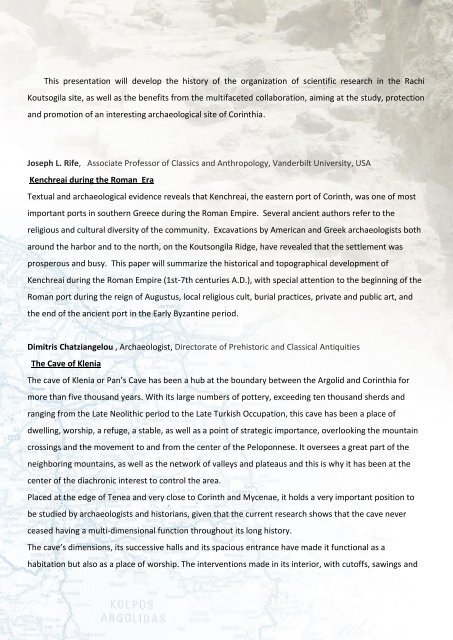ABSTRACTS - The American School of Classical Studies at Athens
ABSTRACTS - The American School of Classical Studies at Athens
ABSTRACTS - The American School of Classical Studies at Athens
Create successful ePaper yourself
Turn your PDF publications into a flip-book with our unique Google optimized e-Paper software.
This present<strong>at</strong>ion will develop the history <strong>of</strong> the organiz<strong>at</strong>ion <strong>of</strong> scientific research in the Rachi<br />
Koutsogila site, as well as the benefits from the multifaceted collabor<strong>at</strong>ion, aiming <strong>at</strong> the study, protection<br />
and promotion <strong>of</strong> an interesting archaeological site <strong>of</strong> Corinthia.<br />
Joseph L. Rife, Associ<strong>at</strong>e Pr<strong>of</strong>essor <strong>of</strong> Classics and Anthropology, Vanderbilt University, USA<br />
Kenchreai during the Roman Era<br />
Textual and archaeological evidence reveals th<strong>at</strong> Kenchreai, the eastern port <strong>of</strong> Corinth, was one <strong>of</strong> most<br />
important ports in southern Greece during the Roman Empire. Several ancient authors refer to the<br />
religious and cultural diversity <strong>of</strong> the community. Excav<strong>at</strong>ions by <strong>American</strong> and Greek archaeologists both<br />
around the harbor and to the north, on the Koutsongila Ridge, have revealed th<strong>at</strong> the settlement was<br />
prosperous and busy. This paper will summarize the historical and topographical development <strong>of</strong><br />
Kenchreai during the Roman Empire (1st-7th centuries A.D.), with special <strong>at</strong>tention to the beginning <strong>of</strong> the<br />
Roman port during the reign <strong>of</strong> Augustus, local religious cult, burial practices, priv<strong>at</strong>e and public art, and<br />
the end <strong>of</strong> the ancient port in the Early Byzantine period.<br />
Dimitris Ch<strong>at</strong>ziangelou , Archaeologist, Director<strong>at</strong>e <strong>of</strong> Prehistoric and <strong>Classical</strong> Antiquities<br />
<strong>The</strong> Cave <strong>of</strong> Klenia<br />
<strong>The</strong> cave <strong>of</strong> Klenia or Pan’s Cave has been a hub <strong>at</strong> the boundary between the Argolid and Corinthia for<br />
more than five thousand years. With its large numbers <strong>of</strong> pottery, exceeding ten thousand sherds and<br />
ranging from the L<strong>at</strong>e Neolithic period to the L<strong>at</strong>e Turkish Occup<strong>at</strong>ion, this cave has been a place <strong>of</strong><br />
dwelling, worship, a refuge, a stable, as well as a point <strong>of</strong> str<strong>at</strong>egic importance, overlooking the mountain<br />
crossings and the movement to and from the center <strong>of</strong> the Peloponnese. It oversees a gre<strong>at</strong> part <strong>of</strong> the<br />
neighboring mountains, as well as the network <strong>of</strong> valleys and pl<strong>at</strong>eaus and this is why it has been <strong>at</strong> the<br />
center <strong>of</strong> the diachronic interest to control the area.<br />
Placed <strong>at</strong> the edge <strong>of</strong> Tenea and very close to Corinth and Mycenae, it holds a very important position to<br />
be studied by archaeologists and historians, given th<strong>at</strong> the current research shows th<strong>at</strong> the cave never<br />
ceased having a multi-dimensional function throughout its long history.<br />
<strong>The</strong> cave’s dimensions, its successive halls and its spacious entrance have made it functional as a<br />
habit<strong>at</strong>ion but also as a place <strong>of</strong> worship. <strong>The</strong> interventions made in its interior, with cut<strong>of</strong>fs, sawings and

















